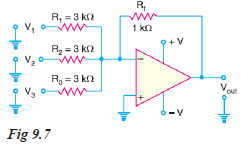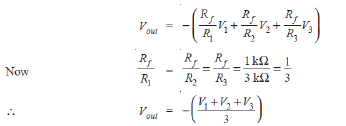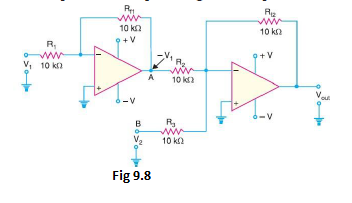- By proper modifications, a summing amplifier can be made to perform many useful functions. There are a number of applications of summing amplifiers. However, we shall discuss the following two applications by way of illustration:
1. as averaging amplifier
2. as subtractor
1. as averaging amplifier: By using the proper input and feedback resistor values, a summing amplifier can be designed to provide an output voltage that is equal to the average of input voltages. A summing amplifier will act as an averaging amplifier when both of the following conditions are met:
(i) All input resistors (R
1, R
2 and so on) are equal in value.
(ii) The ratio of any input resistor to the feedback resistor is equal to the number of input circuits. - Fig. 9.7 shows the circuit of averaging amplifier.

- Note that it is a summing amplifier meeting the above two conditions. All input resistors are equal in value (3 kilo-ohms). If we take the ratio of any input resistor to the feedback resistor, we get 3 kilo-ohms/ 1 kilo-ohm = 3. This is equal to the number of inputs to the circuit. Referring to the circuit in Fig. 9.77, the output voltage is given by;

- Note that Vout is equal to the average of the three inputs. The negative sign shows the phase reversal.
2. As subtractor: A summing amplifier can be used to provide an output voltage that is equal to the difference of two voltages. Such a circuit is called a subtractor and is shown in Fig. 9.7. As we shall see, this circuit will provide an output voltage that is equal to the difference between V
1 and V
2.

- The voltage V
1 is applied to a standard inverting amplifier that has unity gain. Because of this, the output from the inverting amplifier will be equal to –V
1. This output is then applied to the summing amplifier (also having unity gain) along with V
2. Thus output from second OP-amp is given by;
V
out = – (VA + VB) = – (– V
1 + V
2) = V
1 – V
2- It may be noted that the gain of the second stage in the subtractor can be varied to provide an output that is proportional to (rather than equal to) the difference between the input voltages.
- However, if the circuit is to act as a subtractor, the input inverting amplifier must have unity gain. Otherwise, the output will not be proportional to the true difference between V
1 and V
2.
Wilfykil answered the question on
August 16, 2019 at 09:55